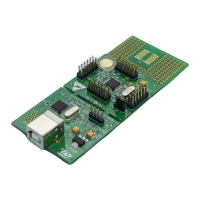Controller area network (beCAN) RM0016
372/449 Doc ID 14587 Rev 8
If the application does not release the mailbox, the next valid message will be stored in the
FIFO which enters pending_2 state (FMP[1:0] = 0b10). The storage process is repeated for
the next valid message putting the FIFO into pending_3 state (FMP[1:0] = 0b11). At this
point, the software must release the output mailbox by setting the RFOM bit, so that a
mailbox is free to store the next valid message. Otherwise the next valid message received
will cause a loss of message.
Refer also to Section 23.6.4: Message storage.
Overrun
Once the FIFO is in pending_3 state (i.e. the three mailboxes are full) the next valid
message reception will lead to an overrun and a message will be lost. The hardware
signals the overrun condition by setting the FOVR bit in the CAN_RFR register. Which
message is lost depends on the configuration of the FIFO:
– If the FIFO lock function is disabled (RFLM bit in the CAN_MCR register cleared)
the last message stored in the FIFO will be overwritten by the new incoming
message. As a result, the last message is always available to the application.
Note: The previously received messages will stay in their positions in the FIFO, only the last one
will be overwritten.
– If the FIFO lock function is enabled (RFLM bit in the CAN_MCR register set) the
most recent message will be discarded and the software will have the three oldest
messages in the FIFO available.
Reception related interrupts
On the storage of the first message in the FIFO - FMP[1:0] bits change from 0b00 to 0b01 -
an interrupt is generated if the FMPIE bit in the CAN_IER register is set.
When the FIFO becomes full (i.e. a third message is stored) the FULL bit in the CAN_RFR
register is set and an interrupt is generated if the FFIE bit in the CAN_IER register is set.
On overrun condition, the FOVR bit is set and an interrupt is generated if the FOVIE bit in
the CAN_IER register is set.
23.6.3 Identifier filtering
In the CAN protocol the identifier of a message is not associated with the address of a node
but related to the content of the message. Consequently a transmitter broadcasts its
message to all receivers. On message reception a receiver node decides - depending on
the identifier value - whether the software needs the message or not. If the message is
needed, it is copied into the RAM. If not, the message must be discarded without
intervention by the software.
To fulfil this requirement, the beCAN Controller provides 6 configurable and scalable filter
banks (5:0) in order to receive only the messages the software needs. This hardware
filtering saves CPU resources which would be otherwise needed to perform filtering by
software. Each filter bank x consists of eight 8-bit registers, CAN_FxR[8:1].

